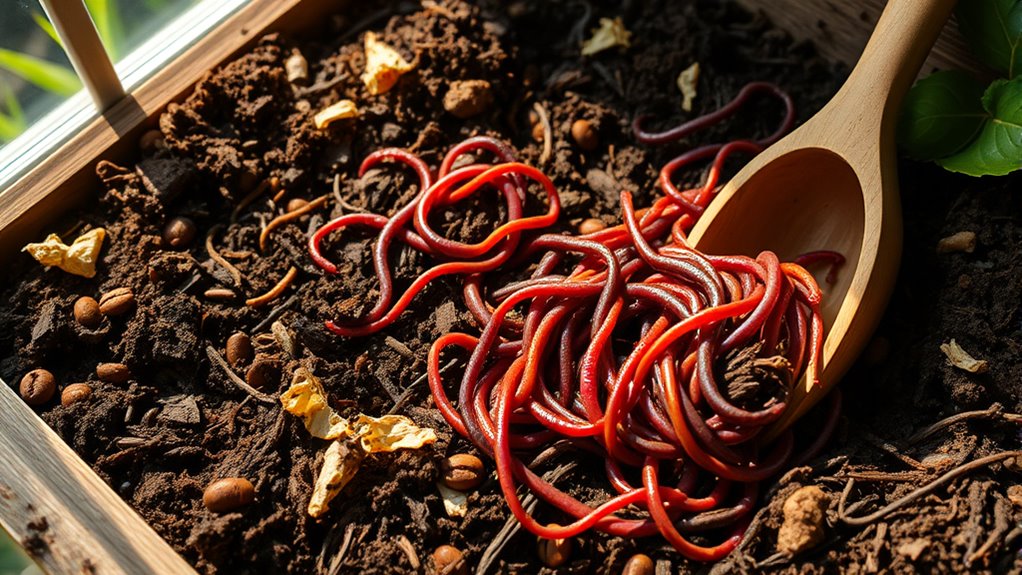If you want to boost your composting game, I've got 14 essential practices to share. First, choose the right worms like Red Wigglers for ideal composting. Next, focus on moisture control and guarantee proper aeration in your bins. Rotate feeding areas regularly, and harvest your nutrient-rich castings every few months for the best results. Stay vigilant about odors and worm health. There's so much more to explore that can enhance your worm farming journey.
Key Takeaways
- Select appropriate worm species like Red Wigglers for efficient composting and optimal nutrient-rich castings.
- Maintain a balanced diet by feeding worms vegetable scraps and avoiding meat, dairy, and oily foods.
- Regularly monitor moisture levels in the bin, keeping it around 70-80% to ensure worm health.
- Use top feeding and bottom harvesting bin designs for easier maintenance and efficient composting processes.
- Rotate feeding areas to promote worm migration and even waste processing, enhancing compost quality.
Worm Farming: The Practical Guide to Natural Composting
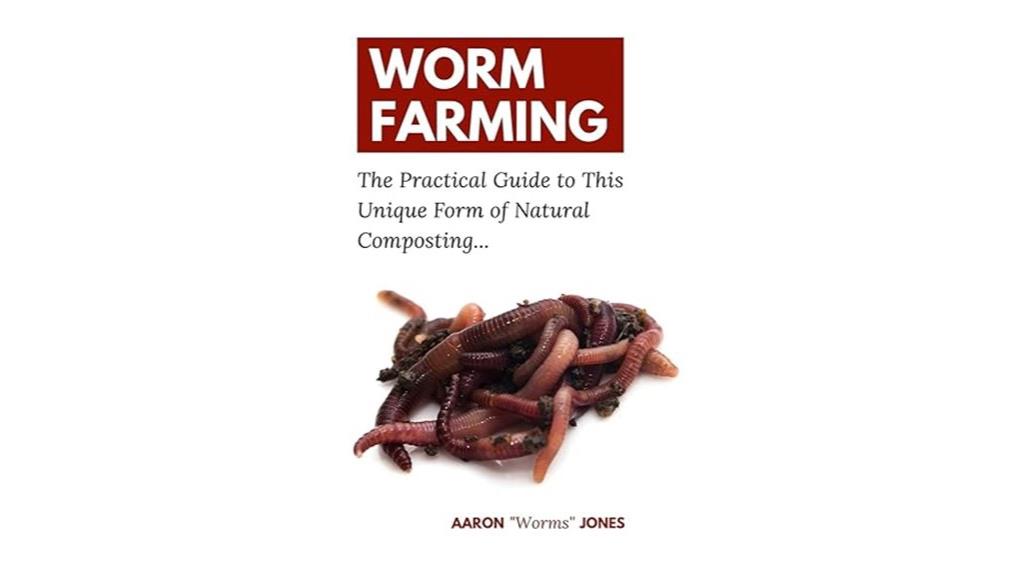
If you're looking to plunge into the world of composting, "Worm Farming: The Practical Guide to Natural Composting" is perfect for you, especially if you're just starting out. This book breaks down the basics of worm farming and vermicomposting in a way that's easy to understand. With simple diagrams and engaging quotes, it keeps you interested throughout. It's not just for adults; kids can learn about composting too! While it offers a solid foundation, keep in mind it's not an exhaustive guide. Still, I found it a delightful read that sparked my curiosity and inspired me to dive deeper.
Best For: Beginners of all ages, especially kids, looking to learn about worm farming and composting.
Pros:
- Provides a clear and engaging introduction to worm farming and vermicomposting.
- Includes simple diagrams and quotes that enhance understanding and maintain interest.
- Compact format offers valuable information that serves as a good starting point for aspiring worm farmers.
Cons:
- Lacks depth in certain areas, making it less suitable for advanced readers.
- Not a detailed how-to guide, which may leave some beginners wanting more specific instructions.
- Some minor typos noted in reviews could detract from the reading experience.
Worm Farming Business Handbook: A Guide to Worm Composting and Vermiculture
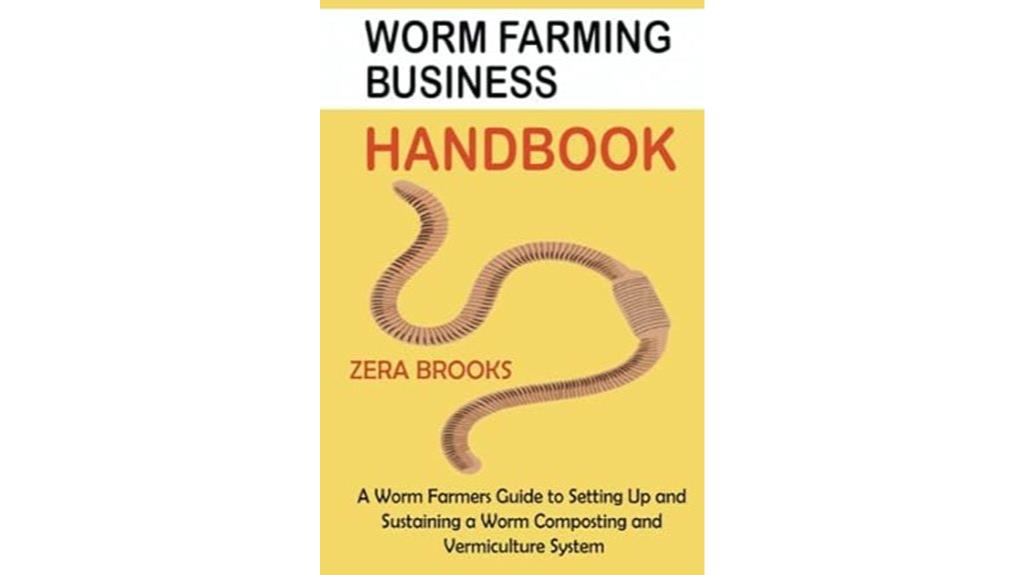
The "Worm Farming Business Handbook" stands out as an excellent resource for beginners keen to explore the world of worm composting and vermiculture. It provides a solid introduction, though experienced farmers might find it a bit shallow. Some formatting and grammar issues, like misspellings and awkward sentence structures, can be distracting. The print version's large font and odd spacing make it less appealing, and the lack of visuals leaves much to be desired. While some readers appreciate its simplicity, others may find it lacking depth. Overall, it's a good starting point, but improvements are definitely needed.
Best For: Beginners interested in worm composting and vermiculture who seek a basic introduction to the subject.
Pros:
- Provides a solid introduction to worm farming concepts for newcomers.
- Easy to read and understand, making it accessible for beginners.
- Offers valuable insights into the basics of worm composting.
Cons:
- Formatting and grammar issues, including misspellings and awkward sentence structures, detract from the reading experience.
- The print version suffers from large fonts and excessive spacing, making it less visually appealing.
- Lacks illustrations and visuals, which could enhance understanding and engagement.
Worm Farming: An Essential Guide to Vermiculture

Worm Farming: An Essential Guide to Vermiculture is perfect for anyone just starting their journey into worm farming. This informative guide breaks down the basics of vermicomposting, making it easy to understand. I appreciate the pros and cons lists for different worm bin setups, which helped me make decisions. While some content might feel repetitive or outdated, it's still packed with practical advice for beginners. If you're looking for troubleshooting tips or how to set up your first bin, this book has you covered. Just keep in mind that advanced challenges might require additional resources beyond this guide.
Best For: Beginners looking to start their journey in worm farming with straightforward guidance and practical advice.
Pros:
- Packed with essential information tailored for new worm farmers.
- Easy-to-understand language and practical troubleshooting tips included.
- Features pros and cons lists for worm bin setups, aiding decision-making.
Cons:
- Some content is repetitive and may feel outdated.
- Lacks depth on advanced topics and challenges in vermiculture.
- Includes irrelevant sections that may not be beneficial for focused worm farming.
The Beginners Guide to Worm Farms and Vermicomposting
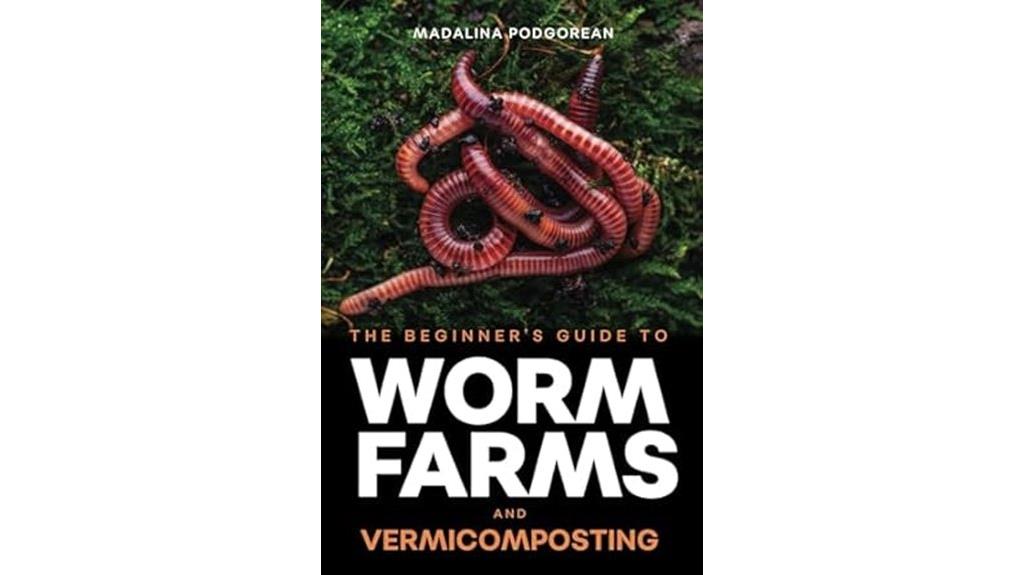
For anyone diving into the world of composting, "The Beginners Guide to Worm Farms and Vermicomposting" stands out as an essential resource. It offers clear and engaging insights perfect for newcomers enthusiastic to enhance their gardening sustainably. I found the step-by-step instructions on starting a worm bin invaluable—covering everything from bedding to avoiding overfeeding. The book emphasizes the benefits of vermicomposting, like enriched soil and healthier plants. Plus, its well-organized layout and helpful visuals make it easy to navigate. I highly recommend this guide to anyone looking to kickstart their worm farming journey!
Best For: Beginners interested in sustainable gardening practices and those looking to enhance their composting efforts with worm farming.
Pros:
- Clear and engaging instructions make it accessible for newcomers.
- Step-by-step guidance on setting up and maintaining a worm bin.
- Well-organized content and helpful visuals aid in comprehension.
Cons:
- Some sentences may be slightly confusing for readers.
- Advanced vermicomposters may find the content too basic.
- Limited coverage of complex issues in worm farming.
The Worm Farmer's Handbook: Mid- to Large-Scale Vermicomposting

If you're serious about diving into vermicomposting on a mid- to large scale, "The Worm Farmer's Handbook" is a fantastic resource. It offers a thorough overview, covering everything from the basics to global worm farming enterprises. You'll find practical dos and don'ts, helping you avoid common pitfalls as you grow. While it's ideal for those planning to start a worm farm, even seasoned farmers will appreciate the insights. Some readers noted a few repetitive sections, but the wealth of information and the author's expertise make it a must-have for anyone passionate about sustainable agriculture. Don't miss out on this invaluable guide!
Best For: Individuals and organizations serious about mid- to large-scale vermicomposting, including farmers, businesses, and educational institutions.
Pros:
- Comprehensive overview of worm farming from basics to advanced practices.
- Practical advice and dos and don'ts that help avoid common mistakes.
- Inspiring insights into environmental sustainability and the potential of worm farming as a business.
Cons:
- Some sections may feel repetitive or slightly boring to readers.
- Excessive focus on the author's travels and international methods may not be practical for all readers.
- Not essential for hobbyists, limiting its audience to more serious vermicomposters.
Vermihut Plus 5-Tray Worm Composter

The Vermihut Plus 5-Tray Worm Composter is ideal for urban dwellers and eco-conscious individuals looking to transform kitchen waste into nutrient-rich compost. With a compact design and a 50-liter capacity, this composter can efficiently handle 10 lbs of worms, reducing 5 lbs of food scraps daily. I love its odorless operation and improved moisture control, ensuring a comfortable environment for my worms. The five trays allow for expansion, and the included M-board enhances airflow. Plus, the customer support is exceptional, providing assistance whenever I need it. Overall, I've found it to be a valuable addition to my composting routine.
Best For: Urban dwellers and eco-conscious individuals seeking to efficiently compost kitchen waste in a compact design.
Pros:
- Odorless operation ensures a pleasant environment while composting.
- Expandable design with 5 trays allows for increased composting capacity.
- Exceptional customer support provides assistance beyond just the purchase.
Cons:
- Some users report concerns about the size being smaller than expected.
- There are occasional issues with worms escaping from the composter.
- Initial setup may require familiarization for optimal performance.
Worms Eat My Garbage, 35th Anniversary Edition: Worm Composting Guide

"Worms Eat My Garbage, 35th Anniversary Edition" is perfect for anyone enthusiastic to plunge into the world of vermicomposting. Authored by the late Mary Applehof, this engaging guide is packed with essential information on worm types, feeding preferences, and bin construction. I love the playful illustrations and practical tools like record sheets that make it easy to keep track of my worm composting journey. While some sections might feel dated for modern setups, the book's beginner-friendly approach has helped me start my own worm bin successfully. It's a fantastic resource for anyone wanting to embrace sustainability and boost their composting game!
Best For: Individuals and families interested in starting a beginner-friendly vermicomposting system to enhance sustainability at home.
Pros:
- Engaging writing style and playful illustrations make the content accessible for all ages.
- Comprehensive guide covering various aspects of worm composting, from bin construction to troubleshooting.
- Practical tools, such as record sheets and metric conversions, support users in managing their worm bins effectively.
Cons:
- Some information may feel outdated for modern small-scale setups or urban apartments.
- Limited detailed instructions for building custom worm beds and managing multi-tier systems.
- Primarily focuses on larger composting operations, which may require adaptation for smaller setups.
The Beginners Guide to Worm Farms and Vermicomposting
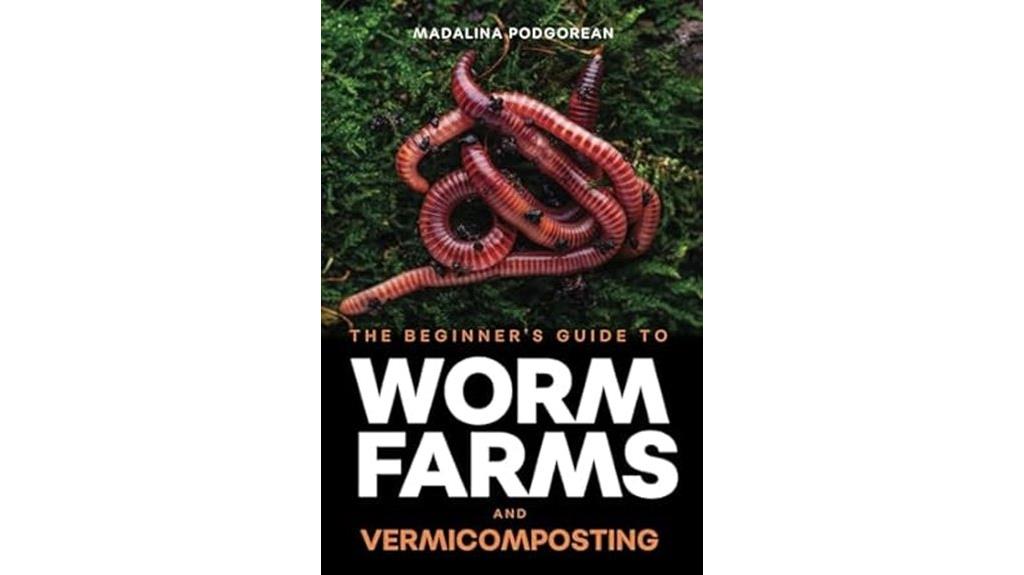
For anyone enthusiastic to immerse themselves in sustainable gardening, "The Beginners Guide to Worm Farms and Vermicomposting" is an excellent choice. This book provides clear, engaging information that helps beginners kickstart their worm bin journey. With step-by-step instructions on bedding, feeding, and maintenance, I found practical tips invaluable, especially on avoiding overfeeding. The benefits are impressive—worm castings enrich soil and boost plant health. Plus, the well-organized layout and helpful visuals make complex concepts easy to grasp. Overall, it's a highly recommended resource for anyone keen to enhance their gardening practices through vermicomposting. You'll love the results!
Best For: Beginners interested in sustainable gardening and vermicomposting who want to enhance their gardening practices.
Pros:
- Provides clear, step-by-step instructions for starting and maintaining a worm bin.
- Highlights the environmental benefits and improvements in plant health through worm castings.
- Features a well-organized layout with visuals that make complex ideas easy to understand.
Cons:
- Some sentences may be slightly confusing for readers.
- Limited advanced techniques for experienced vermicomposters.
- May not cover region-specific worm farming challenges or solutions.
How to Start a Profitable Worm Business on a Shoestring Budget
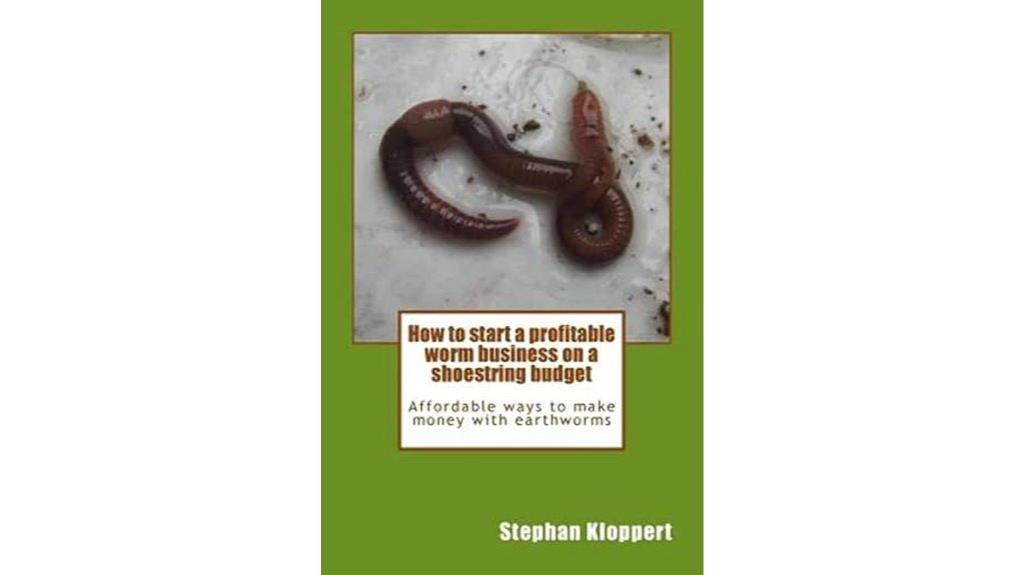
If you're enthusiastic to plunge into the world of worm farming without breaking the bank, this book is perfect for you. It's packed with practical advice to help you set up a profitable worm business. I found the instructions clear and easy to follow, making it great for beginners like me. You'll learn how to efficiently increase your worm population and create breeding stations on a budget. The humor and engaging style make it enjoyable to read. Plus, it really inspires you to take actionable steps towards turning your worm farming dreams into a reality.
Best For: Aspiring worm farmers and eco-conscious individuals looking to start a small business on a budget.
Pros:
- Well-structured and easy to understand, making it accessible for beginners.
- Offers practical, actionable advice for setting up and expanding a worm business.
- Engaging writing style with humor that makes learning enjoyable.
Cons:
- May lack in-depth information for experienced worm farmers.
- Limited focus on advanced techniques or complex business models.
- Some readers might find the content too basic for their needs.
Worm Farming: An Essential Guide to Vermiculture and Vermicomposting
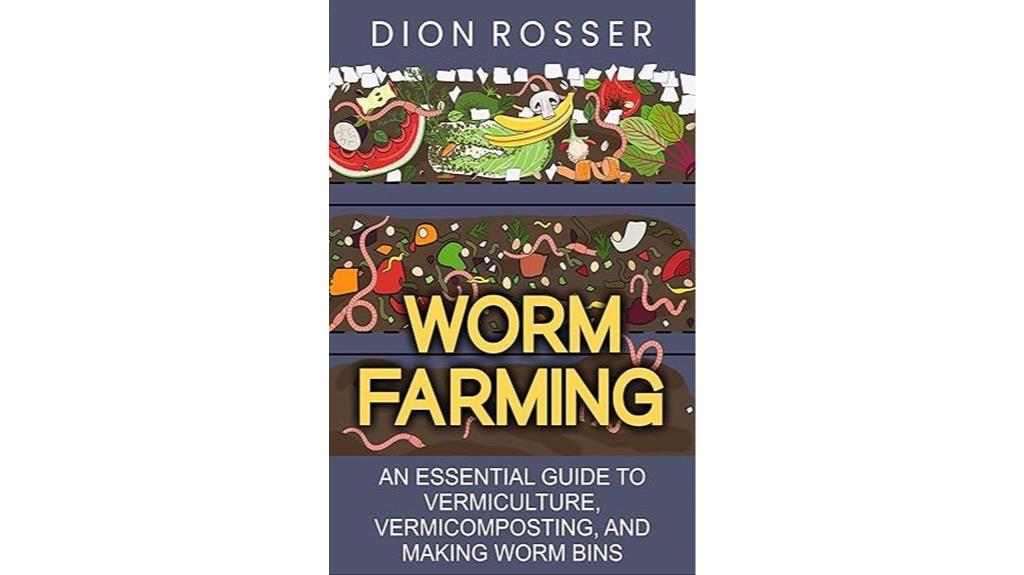
Looking to immerse yourself in the world of vermiculture without feeling overwhelmed? "Worm Farming: An Essential Guide to Vermiculture and Vermicomposting" is perfect for beginners enthusiastic to learn the basics of worm farming. This informative guide breaks down the essentials, covering worm types, bin setups, and practical tips for troubleshooting. While it offers a solid introduction, some sections feel repetitive and lack depth. Readers appreciate the humor and straightforward language, making it a great starting point. However, for advanced challenges, I'd recommend exploring other resources or experienced YouTubers to deepen your knowledge. Happy worm farming!
Best For: Beginners looking to start a worm farming hobby or business with straightforward guidance and practical tips.
Pros:
- Provides a solid introduction to worm farming basics, including worm types and bin setups.
- Written in plain English, making it accessible and easy to understand for newcomers.
- Offers practical troubleshooting advice for common worm bin issues.
Cons:
- Some content feels repetitive and lacks depth, limiting the information available on specific topics.
- Includes outdated information and unrelated sections, which may confuse readers.
- May not address advanced challenges faced by experienced vermiculturists, leaving some readers wanting more comprehensive knowledge.
Urban Worm Bag Worm Composting Bin Version 2
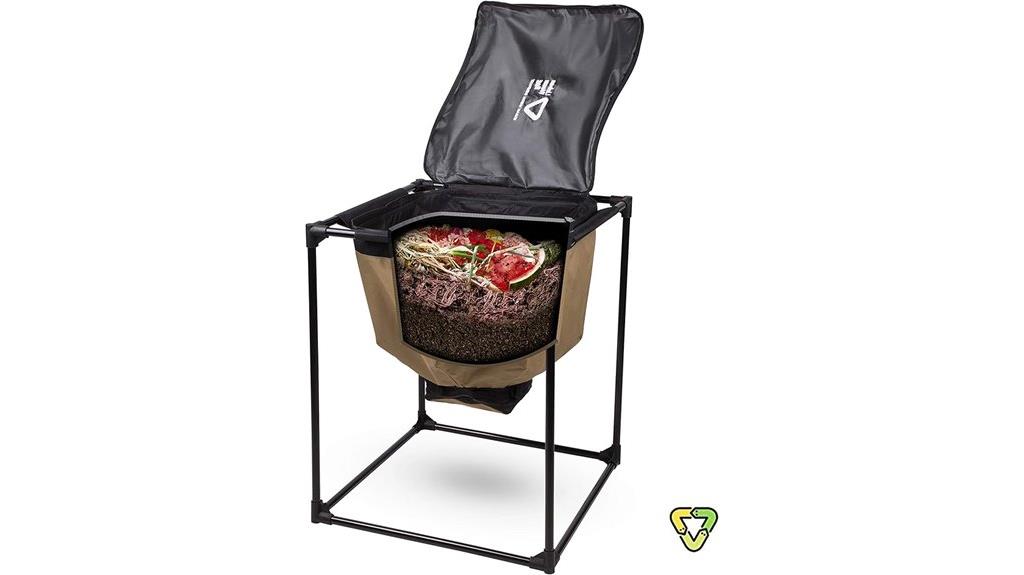
The Urban Worm Bag Worm Composting Bin Version 2 is ideal for those who want an efficient and user-friendly way to compost organic waste without the hassle of separating worms from castings. I love its patent-pending design, allowing me to feed from the top while gathering castings from the bottom seamlessly. Assembly took less than five minutes—no tools required! I've noticed my worm population thriving and even harvested two gallons of castings after a few months. Plus, its compact design fits perfectly in my small space. If you're looking to boost your composting game, I highly recommend it!
Best For: Those looking for an efficient, compact, and user-friendly composting solution that minimizes the hassle of separating worms from castings.
Pros:
- Easy assembly in under five minutes without the need for tools.
- Continuous flow design allows for seamless feeding and harvesting without disturbing worms.
- Compact size makes it suitable for various living spaces, including small apartments.
Cons:
- Initial harvests may contain worms, requiring careful monitoring.
- New bedding may dry out faster than castings, necessitating moisture checks.
- Some users experience a learning curve with vermicomposting techniques.
VIVOSUN 5-Layer Worm Compost Bin (50L)
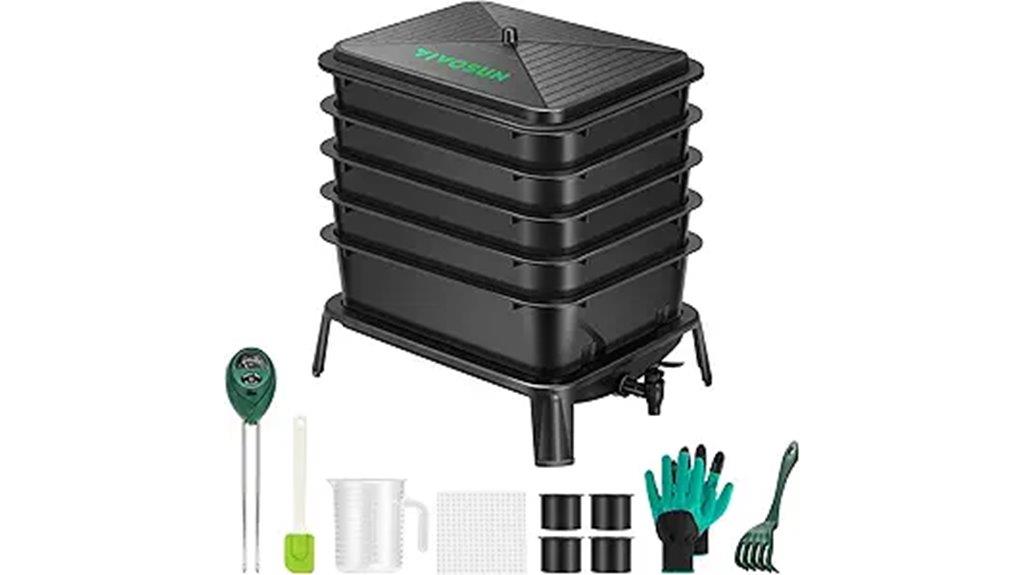
For urban gardeners and composting beginners, the VIVOSUN 5-Layer Worm Compost Bin (50L) offers an efficient and compact solution for transforming kitchen scraps into nutrient-rich compost. It took me just five minutes to set it up, and the integrated design, complete with ventilation slits, keeps odors at bay. I love the stacked trays for easy waste addition and compost removal, plus the included accessories like the measuring cup and gloves make starting a breeze. While I've read mixed reviews on durability, this bin has worked well for me, proving to be a solid starter option for any worm composting enthusiast.
Best For: Urban gardeners and composting beginners looking for an efficient and compact composting solution.
Pros:
- Easy to set up in just five minutes with clear instructions.
- Compact design with stacked trays allows for efficient waste management and compost removal.
- Includes helpful accessories like a measuring cup and gloves for a seamless start.
Cons:
- Mixed reviews regarding the durability of the material, particularly under sunlight.
- Requires regular maintenance and feeding of organic material for optimal composting results.
- Some users may find the initial setup and ongoing care to be time-consuming.
Urban Worm Bag Worm Composting Bin Version 2

Designed with urban gardeners in mind, the Urban Worm Bag Worm Composting Bin Version 2 offers an efficient solution for recycling household waste into nutrient-rich compost. I love its breathable 900D Oxford fabric that keeps moisture in check without excess loss. With a capacity for 8 lbs of worms and the ability to process 3-4 lbs of organic waste daily, it fits perfectly in my small space. Harvesting is a breeze—just feed from the top and collect castings from the bottom. Plus, the DIY frame options make it easy to customize. This bin truly enhances my composting game!
Best For: Urban gardeners and individuals looking to efficiently recycle household waste into compost in small spaces.
Pros:
- Efficient Design: Processes 3-4 lbs of organic waste daily while retaining moisture effectively.
- Easy Harvesting: Simple top-feed method with a no-leak zipper for collecting worm castings from the bottom.
- Customizable: Includes DIY frame instructions for personalized setup.
Cons:
- Assembly Challenges: Some users may find the frame assembly instructions difficult to follow.
- Moisture Control Issues: A few users reported difficulties in managing moisture levels within the bin.
- Limited Warranty Information: Warranty details may not be readily available, leading to uncertainty for buyers.
Worm Bin Garbage Disposal: Farm Red Wiggler Worms for Vermicompost
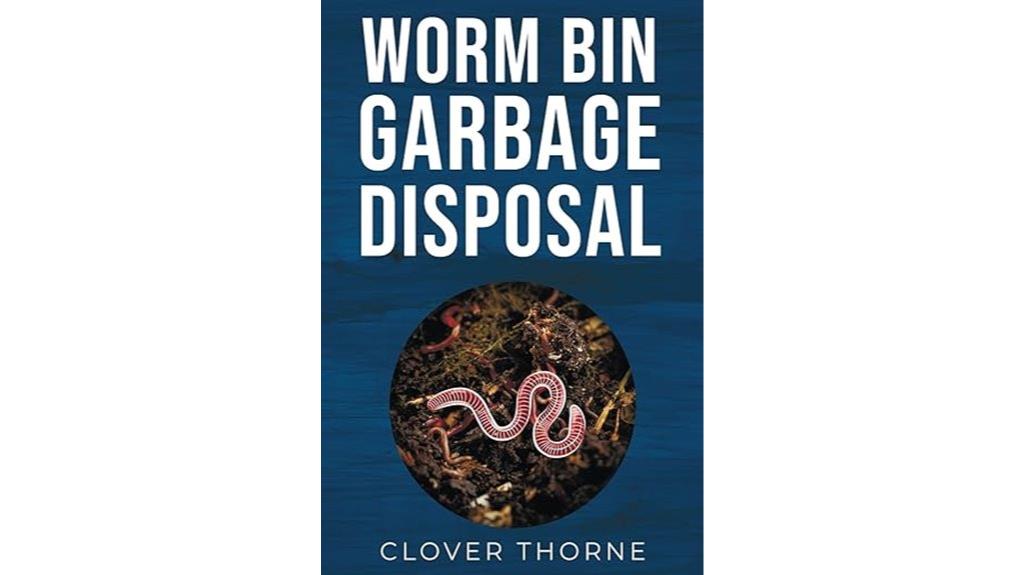
If you're passionate about sustainable gardening and want a practical way to reduce kitchen waste, "Worm Bin Garbage Disposal" is the perfect guide for you. This book simplifies worm composting, helping you create a thriving worm bin for red wigglers. You'll discover various bin setups, from sleek systems to DIY projects, tailored to your space. It teaches you what foods your worms will love and how to care for them like pets. Plus, it tackles common issues like odors and fruit flies, ensuring your vermicomposting journey is smooth. Get ready to harness the power of worm castings, or "black gold," for your garden!
Best For: Individuals interested in sustainable gardening and waste management who want to reduce kitchen waste by creating a worm composting system.
Pros:
- Provides a comprehensive guide for both beginners and experienced composters.
- Offers various worm bin setups, including DIY options for different spaces.
- Emphasizes the benefits of worm castings, enhancing garden health and productivity.
Cons:
- Some sections may contain repetitive information, which could be redundant for experienced readers.
- May require regular maintenance and attention similar to caring for pets.
- New users might initially face challenges with common issues like odors and pests.
Factors to Consider When Choosing Worm Farming
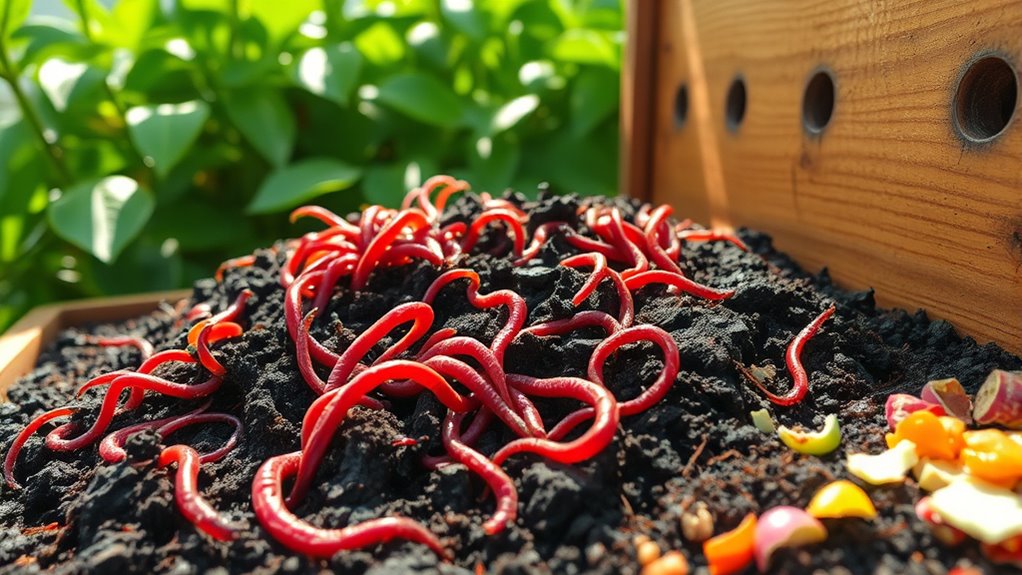
When I started worm farming, I quickly realized how vital it was to take into account several factors. Choosing the right worm species, designing an efficient bin, and understanding feeding and maintenance needs can make or break your success. Let's explore these key points to help you get started on the right foot.
Worm Species Selection
Choosing the right worm species for your farm is essential, as it can greatly impact your composting efficiency and overall success. I've found that the Red Wiggler (Eisenia fetida) is the go-to option for many, thriving in organic waste while producing nutrient-rich castings. If you're looking to compost larger amounts, European Nightcrawlers (Eisenia hortensis) are also great, doubling as fishing bait. For warmer climates, the African Nightcrawler (Eudrilus eugeniae) grows quickly and adapts well, though it needs careful management in cooler temperatures. Don't forget to take into account their reproductive rates; Red Wigglers can double their population in just 60 days. Finally, be mindful of their feeding preferences, as this can influence your composting success.
Bin Design Options
Designing the right bin for worm farming is essential to your success, as it directly impacts the health of your worms and the efficiency of composting. First, consider the size and capacity of your bin; it should accommodate your worm population and the organic waste you plan to process. Aeration features, like ventilation slits, are critical to prevent anaerobic conditions and control odors. Look for designs that allow for top feeding and bottom harvesting, simplifying the composting process. Moisture control is crucial—bins should retain moisture without becoming waterlogged. Finally, ease of maintenance matters; removable trays or accessible points make monitoring and cleaning much easier. By keeping these factors in mind, you'll create a thriving environment for your worms.
Space and Location
Finding the right space for your worm farm is vital for its success. I always look for an area that maintains a consistent temperature between 55 and 77 degrees Fahrenheit, since extreme heat or cold can harm my worms. Adequate ventilation is essential too; it helps prevent harmful gas buildup and keeps the environment healthy. I also make sure I have easy access to a water source to maintain the moisture levels in my worm bin. Remember, worms thrive in moist conditions but can drown if it's too wet. Finally, I protect my setup from direct sunlight, as excessive heat can dry out the bedding and stress my worms. The space should match the scale of my operation for ideal airflow.
Feeding Requirements
When it comes to feeding my worms, I've learned that a balanced diet is essential for their health and productivity. I primarily give my red wigglers vegetable scraps, fruit peels, and coffee grounds, but I steer clear of meat, dairy, and oily foods to avoid odors and pests. I also pay attention to the moisture level in their bedding and food, keeping it around 70-80% to guarantee they thrive. I find that feeding them every few days to once a week works best, depending on how quickly they consume the scraps. Additionally, I incorporate shredded paper or cardboard, which helps absorb excess moisture and serves as a valuable food source as it breaks down.
Maintenance Practices
Maintaining a successful worm farm involves several key practices that can greatly impact its overall health and productivity. First, I regularly monitor moisture levels in the worm bin. Worms thrive in damp environments, but too much moisture can create anaerobic conditions and unpleasant odors. I also guarantee a balanced diet for my worms by feeding them appropriate organic waste while avoiding dairy, meat, and oily foods. Rotating feeding areas encourages worms to migrate, promoting even processing of waste. Additionally, I keep an eye on their health by checking for signs of distress, such as unusual behavior or odors. By staying attentive to these maintenance practices, I can guarantee my worm farm flourishes.
Temperature Control
As I focus on maintenance practices, temperature control becomes an essential factor in guaranteeing my worm farm's success. Red wiggler worms thrive best between 55°F and 77°F (13°C to 25°C). I make it a priority to keep the temperature within this range to promote their health and composting efficiency. Extreme temperatures, above 85°F or below 32°F, can stress or even kill my worms, so I closely monitor their environment. Using thermally insulated bins or placing them in shaded areas helps regulate temperature fluctuations, especially outdoors. I also guarantee proper ventilation within the bins to encourage airflow and prevent overheating. Finally, I regularly check the moisture level in the bedding, as dry conditions can lead to harmful temperature spikes.
Harvesting Techniques
Choosing the right harvesting technique for worm castings is essential to maximizing both efficiency and worm health. I often use the light method, where I move the worms to one side of the bin, allowing me to collect the castings from the other side in about 15-30 minutes. Alternatively, the screening method involves sifting castings through a mesh screen, which can be effective but requires extra tools. I usually harvest every 4 to 6 months, keeping an eye on my worm population and bin conditions. Regularly monitoring moisture levels is vital, as damp castings make extraction easier and keep the worms healthy. I prefer harvesting in batches, ensuring I always have nutrient-rich castings ready for my garden.
Frequently Asked Questions
How Do I Maintain Optimal Moisture Levels in My Worm Bin?
Maintaining ideal moisture levels in my worm bin is essential for healthy worms. I check the moisture by feeling the bedding; it should feel like a damp sponge. If it's too dry, I add a little water or damp food scraps. If it's too wet, I mix in dry bedding or shredded paper. I also guarantee proper drainage to prevent water buildup. Regular monitoring keeps my worms happy and thriving!
What Types of Worms Are Best for Composting?
Did you know that a single mature worm can consume up to half its weight in organic matter every day? When it comes to composting, I've found that red wigglers (Eisenia fetida) are the best choice. They thrive in bins, eat kitchen scraps, and produce rich castings. European nightcrawlers are another great option, as they can handle a bit of cold. I've had fantastic results with both, making my composting journey much easier!
Can I Compost Meat or Dairy With Worms?
I wouldn't recommend composting meat or dairy with worms. I've tried it before, and it led to unpleasant odors and attracted pests. Worms thrive on vegetable scraps, fruits, and paper products instead. They break down these materials effectively, creating rich compost without the hassle. If you want to keep your worm bin healthy and odor-free, stick to those plant-based scraps. It's the best way to guarantee your worms stay happy and productive!
How Often Should I Feed My Worms?
I usually feed my worms every few days, depending on how quickly they're consuming their food. I've found that offering small amounts helps prevent overfeeding and keeps them happy. I keep an eye on their activity and the food levels; if it's gone quickly, I know they're hungry! Just remember, balance is key, so I try to vary their diet to keep them healthy and thriving.
What Are the Signs That My Worms Are Unhealthy?
Have you ever watched something you care about struggle? It's heartbreaking. When my worms are unhealthy, I notice a few telltale signs. They become sluggish, avoid food, or even start climbing out of their bin. If I see an unpleasant odor or a significant decrease in their population, it's time to act. Paying close attention to these signs helps me guarantee my worm friends thrive, and that's truly rewarding!
Conclusion
In wrapping up, I can't stress enough how transforming worm farming can be for your composting efforts—it's like revealing a secret garden of nutrient-rich soil! By following the best practices outlined, you'll not only boost your composting game but also contribute to a healthier planet. So, let's embrace these wriggly wonders and watch our gardens thrive like never before. Immerse yourself, and you'll see just how remarkable vermiculture can be!
